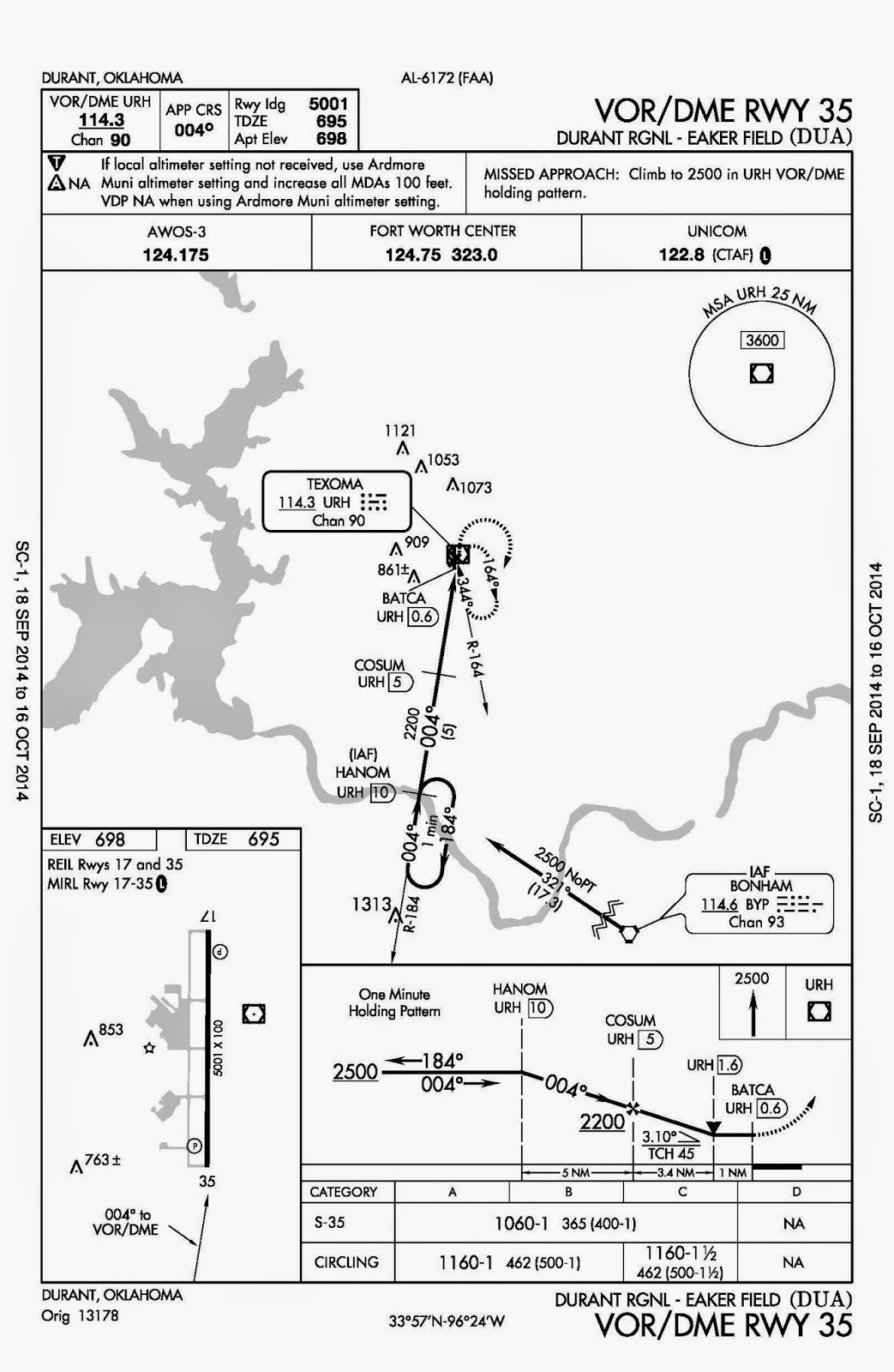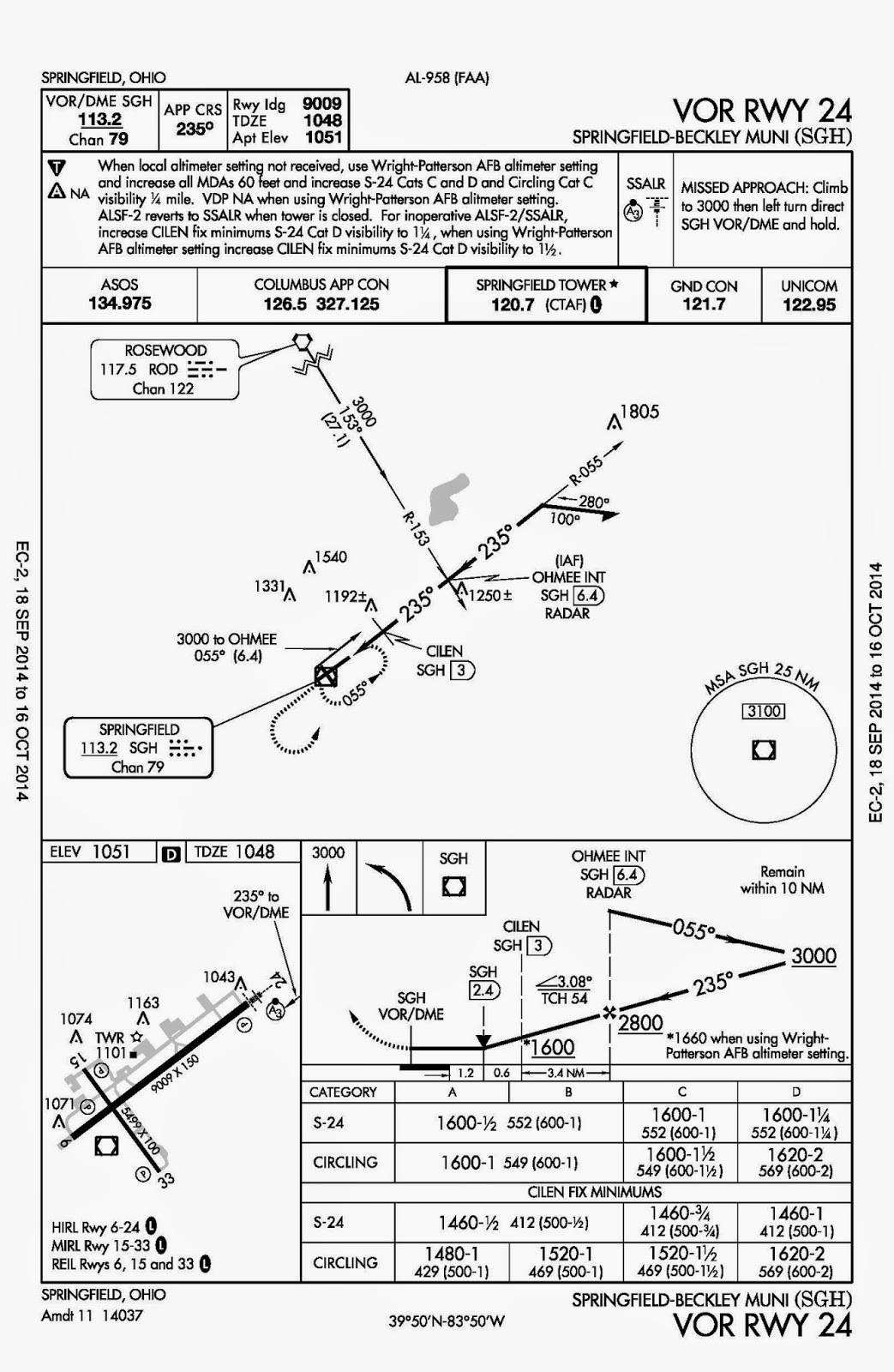There has been a very active discussion occurring on the
Pilots of America web board the last couple of weeks regarding a
Hold-in-Lieu-of-Procedure-Turn (hereafter HILPT) published on an approach chart
in southern Oklahoma. Sadly, as is the case with many online forums, the
discussion has degraded into name-calling, insults and other unproductive and
uneducational matters. So I'll try to break it down here.
The approach in question is the Durant, OK (KDUA) VOR/DME
RWY 35.
Notice there is one published way for a non-GPS-equipped
aircraft to enter this procedure without receiving radar vectors to final. That
aircraft would start at the BYP VORTAC IAF, fly the BYP-321 radial until HANOM,
turn right, then proceed inbound to the URH VOR/DME on the URH-184 radial.
There is a HILPT published at HANOM, but since the route from BYP is labeled
NoPT, you would not fly the HILPT coming from that direction.
Well, then from what direction DO you fly the HILPT?
Seems like an easy answer, that you'd fly the HILPT if
you were coming at the approach from the north - you'd fly to the URH VOR/DME,
then outbound on the 184 radial to HANOM, execute the HILPT and proceed
inbound. Except it's not quite that easy, for one main reason:
There is no published segment from URH to HANOM.
Sure, there's a published route from HANOM to URH, but
that's not the same thing. A route from URH to HANOM would be properly
identified by a thin line as a feeder route. Note that the indication "R-184" below the HILPT does not indicate a route, it is simply showing what radial the final approach course is on. A route would be indicated by an altitude, a course, and a distance. So what is missing here is a charted,
evaluated, and published route from URH to HANOM. Note that courses on
instrument approaches are one-way, not two-ways like on most airways, and aren't
meant to be flown backwards. This is why each segment of an approach has a
directional arrow.
This is especially confusing because the URH VOR/DME is right on an airway - V63 - so it would be a logical place to have a feeder. Would it be possible to fly that route, from URH to HANOM
and turn around? Of course - any instrument pilot should be able to do it with
no problem. But from the way this procedure is charted, that exact route has
not been evaluated for obstacles, even though the route the other way has been
(the intermediate and final segments).
Why does this matter? It seems from looking at it that
flying from URH to HANOM at an altitude of, say 2500 should work just fine. The
reason has mainly to do with the difference in size of the areas evaluated by
TERPS for intermediate and final segments versus a feeder route; the area
evaluated for a VOR final being much narrower than for a feeder route. (At the
VOR, the final is 1nm each side of center, whereas the feeder is 4nm each side
of center, not considering what are known as "secondary areas" (see
my 3/30/14 blog post for more about secondary areas.)
Let's say you're approaching the VOR in such a way that
you need to make a 90 degree turn to go outbound on the uncharted
"feeder" route from URH to HANOM. An actual feeder route, being
wider, allows for you crossing the VOR, then beginning your turn, with enough
area to contain the turn radius. A final segment used in reverse would not have
this, as the area is much smaller (and turns to line up on final are much more
restricted in terms of heading change for this reason). Might not be a problem
in a 172, but in something faster it could. What if there is an antenna tower
or mountain off to the side of final?
Sometimes a picture is worth more than 1000 words. This
is probably such a situation:
This diagram shows a notional view of the areas evaluated
for this approach. Since the area from HANOM to URH has been evaluated as a
final approach segment, it's pretty narrow. But if an aircraft inbound from the
east crossed the VOR and made a turn to proceed outbound on the final approach
course, it could easily exceed the boundaries of the evaluated area. At 150
knots, a standard-rate turn results in a turn radius of about 0.8 nm. The final
approach area is only 1.0 nm wide at the VOR, so while it seems to fit, that's
only in an ideal situation. Adding in a tailwind that will increase turn
radius, a slightly delayed start of the turn, and imperfect pilot technique
means you rapidly run out of safety margin. What's outside of that area? Could
be an antenna tower, could be a mountain, or it could be level terrain as far as the eye can see. There's no telling, but the published altitude doesn't
reflect that because it wasn't part of the evaluation.
Compare that to the case if a feeder route was published
from URH to HANOM. The feeder route, being much wider for exactly this reason,
easily accommodates the turn radius:
So, if we can't fly from URH to HANOM for the HILPT, and
if the only published route from BYP to HANOM is a NoPT segment, what's the
purpose of the HILPT in the first place? There is none. I speculate that the
HILPT is charted correctly, but that a feeder was erroneously left off during
publication. This has been brought to the FAA's attention, so it will be
interesting to see their response.
An example of a similar procedure that has the
feeder and the Procedure Turn (though not a HILPT) charted is the Springfield, OH VOR RWY 24. Notice the thin line from the SGH VOR labeled "300 to OHMEE, 055 deg, (6.4)". It has all the necessary data to serve as a feeder route and has been evaluated and charted. Thanks to a blog reader (and former student) for providing this example!

